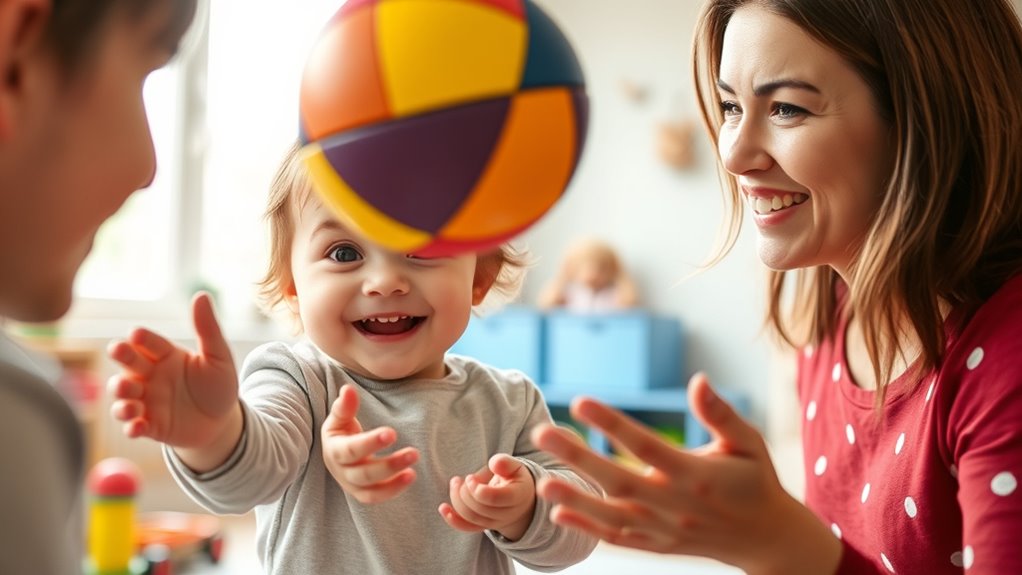Serve-and-return play helps your child build crucial brain connections, develop language skills, and gain social confidence. When you respond to your child’s cues, you create a safe, trusting environment that encourages exploration and learning. These simple interactions teach patience, turn-taking, and problem-solving, laying the groundwork for lifelong skills. Small moments like these have a big impact. Keep exploring how this powerful approach can make a lasting difference in your child’s growth.
Key Takeaways
- Serve-and-return play builds strong emotional bonds, creating a secure foundation for effective learning and exploration.
- It models and reinforces language skills, enhancing vocabulary and communication abilities essential for academic success.
- Engaging in serve-and-return interactions develops social skills like patience, turn-taking, and understanding social cues.
- This responsive interaction stimulates brain development, supporting cognitive growth and critical thinking skills.
- Regular serve-and-return play transforms everyday moments into powerful learning opportunities, fostering confident, well-rounded learners.

Ever wondered how simple interactions can boost your child’s development? That’s the core idea behind serve-and-return play, a natural and powerful way to support your little one’s growth. When you respond to your child’s cues—whether it’s a babble, a gesture, or a smile—you create a foundation of emotional bonding that’s essential for their overall well-being. These exchanges aren’t just cute moments; they’re fundamental building blocks for healthy brain development and social skills. As you engage in this back-and-forth, you’re helping your child feel secure and valued, which encourages them to explore and learn more confidently.
Responding to your child’s cues builds emotional bonds and supports healthy development.
One of the key benefits of serve-and-return play is its role in fostering emotional bonding. When you attentively respond to your child’s signals, you communicate that they are heard and understood. This sense of connection is indispensable because it builds trust and emotional security. Your child begins to associate your interactions with safety and comfort, which encourages more communication and interaction over time. This emotional bond acts like a catalyst, making your child more receptive and enthusiastic to engage in learning activities. It’s not just about responding; it’s about creating a relationship where your child feels safe to express themselves, experiment, and grow.
Additionally, serve-and-return play is a powerful tool for language development. By responding to your child’s sounds, gestures, or facial expressions, you’re modeling language and encouraging your child to communicate. When you mimic their sounds or expand on what they say, you reinforce their understanding of language structures and vocabulary. These frequent, responsive exchanges help your child develop the foundational skills for speaking and understanding words. The more you engage in these conversations, the more your child’s brain forms neural connections related to language, making it easier for them to acquire new words and express themselves effectively. Incorporating responsive, eco-friendly materials can also make these interactions more engaging and comfortable for your child.
This process also nurtures your child’s social and cognitive skills. As you take turns and respond appropriately, your child learns about patience, turn-taking, and social cues. These interactions encourage curiosity and problem-solving, as your child seeks your response and figures out how to engage with you. Over time, serve-and-return play transforms your everyday interactions into rich learning experiences that shape your child’s ability to think critically, communicate clearly, and build meaningful relationships. It’s a simple act with profound impact—one that turns everyday moments into powerful opportunities for learning and connection.
Frequently Asked Questions
How Does Serve-And-Return Play Influence Language Development?
Serve-and-return play boosts language development by encouraging you to engage actively with your child through peer interactions and emotional bonding. When you respond to their cues, you help them practice communication skills, expand their vocabulary, and understand social cues. This back-and-forth creates a safe space for them to experiment with language, building confidence and fostering a deeper emotional connection that supports their overall growth and learning.
What Age Is Most Critical for Serve-And-Return Interactions?
You might wonder when serve-and-return interactions are most crucial. The answer is during early childhood, as this period shapes key developmental milestones. During these years, caregiver engagement acts like a catalyst, fostering emotional bonds and cognitive growth. Missing out on this essential window could slow progress. So, stay attentive early on—because the foundation for lifelong learning is built through these precious, formative exchanges.
Can Serve-And-Return Play Be Effective for Children With Developmental Delays?
You can make serve-and-return play effective for children with developmental delays by using adaptive strategies and inclusive methods. Adjust your interactions to meet their unique needs, like simplifying cues or offering more time for responses. Incorporate visual aids or sensory tools to support communication. By tailoring your approach, you help build their confidence and engagement, fostering learning and connection regardless of developmental challenges.
How Can Parents Encourage Serve-And-Return in Everyday Routines?
You can encourage serve-and-return during daily routines by actively engaging with your child through simple activities like mealtime conversations or bath time. Respond promptly and warmly to their cues, fostering parental engagement that builds trust and communication. Make eye contact, listen attentively, and ask open-ended questions. Incorporating these interactions into everyday moments helps your child develop essential social and emotional skills, setting a strong foundation for lifelong learning.
Are There Cultural Differences in Serve-And-Return Play Practices?
You might notice cultural perceptions and play traditions influence serve-and-return practices across different communities. Some cultures emphasize verbal interactions, while others focus on physical play or storytelling. These variations shape how children engage with caregivers, but the core idea remains the same: responsive exchanges foster learning and emotional bonds. Recognizing and respecting these cultural differences helps you support your child’s development in ways that align with your traditions and values.
Conclusion
By engaging in serve-and-return play, you help shape your child’s brain development, setting the foundation for lifelong learning. Did you know that children who regularly experience responsive interactions score higher on cognitive tests? When you respond thoughtfully to their cues, you’re not just playing—you’re nurturing their ability to think, communicate, and thrive. So, keep those exchanges lively and supportive; you’re building skills that will benefit your child for years to come.











